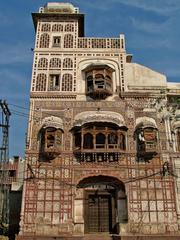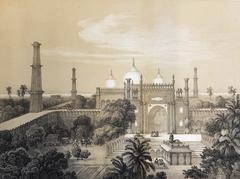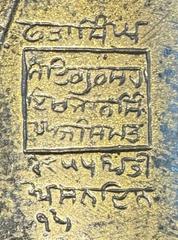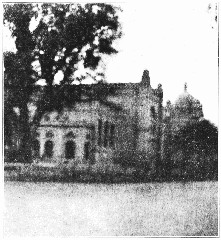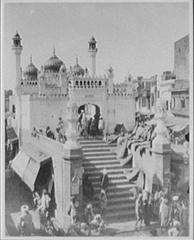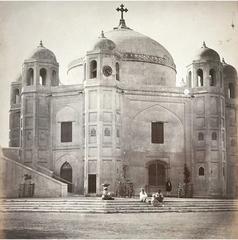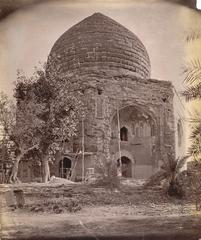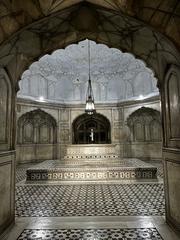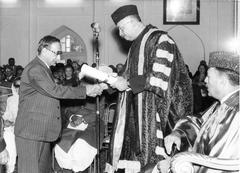Tomb of Ali Mardan Khan Lahore: Visiting Hours, Tickets, and Comprehensive Guide
Date: 04/07/2025
Introduction
The Tomb of Ali Mardan Khan stands as one of Lahore’s most significant Mughal-era monuments, bearing witness to the city’s rich historical, architectural, and cultural legacy. Erected in the 17th century during the height of Mughal power, this mausoleum not only offers insight into the life and achievements of Ali Mardan Khan—a renowned Mughal nobleman and engineer—but also encapsulates the era’s vision of harmonious urban planning, garden artistry, and architectural innovation. This guide provides detailed information about the tomb’s history, architectural features, visiting hours, ticketing, accessibility, and travel tips, alongside recommendations for nearby historical sites to enrich your Lahore experience.
Table of Contents
- Historical Background
- Architectural and Cultural Significance
- The Tomb: Construction, Setting, and Later Transformations
- Conservation Efforts and Current Status
- Visiting Information
- Nearby Attractions
- Visitor FAQs
- Visuals and Media Resources
- Conclusion and Final Recommendations
- References
Historical Background
Life and Legacy of Ali Mardan Khan
Ali Mardan Khan was a Persian noble of Kurdish origin, the son of Ganj Ali Khan—a distinguished military governor in Safavid Iran. His early career was marked by service to Shah Abbas I, but after political instability and the ascension of Shah Safi, he sought refuge in the Mughal Empire. Ali Mardan Khan’s defection in 1632 was met with favor at the Mughal court under Emperor Shah Jahan, where he rapidly ascended to influential administrative and engineering roles (Daily Times; city-history.com).
Contributions to Mughal Infrastructure and Architecture
Celebrated for his engineering acumen, Ali Mardan Khan masterminded crucial hydraulic and architectural projects. Among his most enduring legacies is the canal system that irrigated Lahore’s Shalimar Gardens, a hallmark of Mughal landscape design. He also contributed to major waterworks in Delhi, Kashmir, Peshawar, and Kabul, and was responsible for numerous gardens and caravanserais, reflecting his deep commitment to integrating nature, architecture, and urban life (Pak Heritage; Worldys News).
Architectural and Cultural Significance
The Tomb of Ali Mardan Khan is a quintessential example of Mughal funerary architecture, blending Persian influences with Indian craftsmanship. Constructed in the mid-17th century, the tomb was initially intended for his mother, with Ali Mardan Khan and his sister later interred here as well. The mausoleum’s octagonal plan, double dome, and remnants of intricate tilework and frescoes exemplify the aesthetic ideals of its time (Pak Heritage).
Set within what was once the lush Gulabi Bagh (Rose Garden), the tomb’s layout followed the charbagh (four-part garden) paradigm—a symbolic representation of paradise in Islamic culture. Surviving architectural details, such as high pishtaqs (arched portals), chattris (domed kiosks), and elaborate kashi kari (tilework), underscore its original grandeur.

The Tomb: Construction, Setting, and Later Transformations
Originally surrounded by a walled garden, the tomb’s design harmonized architecture and landscape. The structure itself is octagonal, constructed from brick and clad in red sandstone with inlaid marble. The main chamber houses the cenotaph, while the actual graves lie in the basement—a Mughal tradition.
Over time, especially during the Sikh and colonial periods, the tomb suffered extensive neglect and repurposing. Its gardens were lost to urban development, and the structure was used variously as a military magazine and residence. Today, the tomb stands isolated, surrounded by railway infrastructure, its elaborate gateways and chattris largely vanished (Daily Times; city-history.com).
Conservation Efforts and Current Status
Recent years have witnessed renewed efforts to conserve and restore the Tomb of Ali Mardan Khan. The Punjab Archaeology Department, in collaboration with local authorities and heritage organizations, has initiated stabilization and restoration projects. Access remains restricted due to the tomb’s location within railway property, but ongoing advocacy and incremental improvements are making visits increasingly feasible (Worldys News; The Friday Times).
Visiting Information
Location and Access
- Address: Gulabi Bagh, Mughalpura, Lahore, Pakistan.
- Getting There: The tomb is approximately 7 kilometers northeast of Lahore Railway Station and accessible via GT Road. Public transport, rickshaws, and the Yateem Khana Metrobus station (about 2 km away) are convenient options (Dawn).
Hours and Ticketing
- Visiting Hours: Generally open daily from sunrise to sunset, though access may be limited during restoration or specific religious events. In some cases, visits are allowed only on Thursdays or by prior arrangement with the Archaeology Department (city-history.com).
- Entry Fee: No official ticketing system or fee; donations for site upkeep are appreciated.
Accessibility
- The approach to the tomb involves uneven paths and steps, and the site is not fully wheelchair accessible.
- Exercise caution near the elevated platform and railway lines. Comfortable footwear is recommended.
Practical Travel Tips
- Facilities: There are no dedicated restrooms, cafes, or souvenir shops at the site. Bring bottled water, especially in hot weather.
- Dress Code: Modest attire covering shoulders and knees is expected; shoes should be removed when entering the inner chamber.
- Etiquette: Respect the cultural and religious significance of the site. Avoid loud behavior and littering.
- Guided Tours: No official tours are provided, but local guides may be found near the entrance for informal tours. For deeper insight, research ahead or use mobile resources such as Google Arts & Culture.
Nearby Attractions
Enhance your visit by exploring other prominent Lahore historical sites:
- Shalimar Gardens: A UNESCO World Heritage Site and an exemplar of Mughal landscape design (UNESCO World Heritage).
- Lahore Fort: Iconic for its Mughal military and palatial structures.
- Badshahi Mosque: One of the world’s largest mosques.
- Hazuri Bagh: A picturesque garden near Lahore Fort.
Visitor FAQs
Q: Are there any entry fees or tickets required to visit the Tomb of Ali Mardan Khan?
A: No formal tickets or entry fees are required, though donations for site upkeep are welcomed.
Q: What are the visiting hours for the tomb?
A: Open from sunrise to sunset daily, but access may be limited during restoration or religious events. Check current status before your visit.
Q: Is the tomb wheelchair accessible?
A: The site is not fully wheelchair accessible due to uneven terrain and steps.
Q: Are guided tours available?
A: No official tours, but local guides may offer informal tours for a negotiable fee.
Q: Can I take photographs at the site?
A: Yes, photography is allowed. Early morning or late afternoon offers the best lighting.
Q: What is the best way to reach the tomb?
A: By car, rickshaw, or public transport from central Lahore. Parking is limited.
Visuals and Media Resources
- For high-quality images and interactive maps, refer to Archnet and Google Arts & Culture.
- Alt text suggestions: “Tomb of Ali Mardan Khan exterior with blue kashi kari tilework,” “Octagonal plan of the Mughal mausoleum,” “Double-storey gateway at Ali Mardan Khan’s tomb.”
Conclusion and Final Recommendations
The Tomb of Ali Mardan Khan is more than a historical relic—it is a living chronicle of Lahore’s Mughal glory and the cross-cultural currents that shaped South Asia. Despite challenges of neglect and restricted access, ongoing conservation and rising public interest offer hope for the site’s revival as a key heritage destination.
Plan your visit by confirming access days and hours, dress respectfully, and combine your exploration with other nearby Mughal-era landmarks for a complete experience. For up-to-date information, digital guides, and exclusive content, download the Audiala app and follow official heritage channels.
Immerse yourself in Lahore’s history by experiencing this hidden gem—a monument to engineering brilliance, artistic vision, and the enduring spirit of the Mughal Empire.
References
- Tomb of Ali Mardan: A Lost Chapter of History, Daily Times
- Tomb of Ali Mardan Khan, Pak Heritage
- Lahore Nawab Ali Mardan’s Masterpiece Mausoleum Has Become a Ruin After the Lock Was Not Opened, Worldys News
- The Tomb of Ali Mardan Khan, The Friday Times
- The Mughal Heritage of Lahore, Google Arts & Culture
- Archnet: Tomb of Ali Mardan Khan
- UNESCO World Heritage: Lahore Fort and Shalimar Gardens
- Travel.State.Gov: Pakistan Travel Information
- Walled City of Lahore Authority
- Dawn: Lahore Heritage
